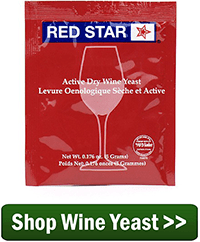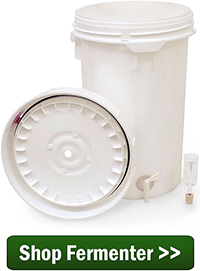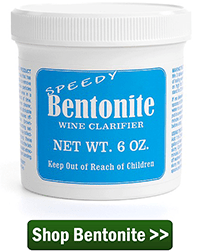 The BeerSmith blog featured a video interview back in 2015 that had some very good insights to making mead. It was with the founder of Moonlight Meadery, Michael Fairbrother, how to brew your own mead. As I’m planning on making my first mead, I thought I’d share some of the mead making tips I learned from the video.
The BeerSmith blog featured a video interview back in 2015 that had some very good insights to making mead. It was with the founder of Moonlight Meadery, Michael Fairbrother, how to brew your own mead. As I’m planning on making my first mead, I thought I’d share some of the mead making tips I learned from the video.
Below are some of Michael’s key mead making tips. There’s enough clear-cut information here that you will be able to create your own mead recipe:
Water
- Use clean, filtered, or reverse osmosis water for your mead.
Honey
- Use fresh, non-pasteurized honey whenever possible for best flavor. See the honey locator at honey.com to find fresh, raw honey near you!
- Different honeys have different flavors: tupelo honey tends to be spicy, and citrus honey might have notes of orange.
- Michael recommends using cranberry, blueberry, blackberry, and avocado honeys, among others.
- Michael does not recommend buckwheat or heather honey, as these tend to be heavy.
- Michael suggests a honey to water ratio of 25:75 for a semi-sweet mead. Use more honey for a sweeter mead, less honey for a drier mead.

Yeast
- One of Michaels biggest mead making tips is do not use champagne yeast.
- Michael uses Lalvin 71B wine yeast for all of his meads.
- Pitch about 1 gram of yeast per gallon for a healthy fermentation.
Equipment
If you’re a homebrewer or winemaker, you probably already have all the equipment you need for making mead.
- Use a fermenting bucket for primary fermentation. It’s easier to stir the must and helps prevent some kind of blow-off situation.
- After primary fermentation, move the mead to a carboy and minimize headspace.

Yeast Nutrients
- Always rehydrate your yeast nutrient in a pint of water.
- For best results, divide your yeast nutrient by four and pitch it four times during primary fermentation: at 0, 24, 48, and 72 hrs into fermentation. This will help the mead develop more quickly.
Fermentation
- Primary fermentation – Michael usually lets his mead sit for three months before racking to a secondary fermenter.
- Ferment at about 62°F. This is one of Fairbrother’s favorite mead making tips. The cooler temperature will result in a longer fermentation, but with a cleaner tasting mead.
- Michael recommends using bentonite or a wine filter to get good clarity.
- Sulfites or sorbates can be used to keep the mead stable after fermentation.
- Flavorings – Moonlight’s most popular mead is made with apple, honey, cinnamon, and vanilla.
- Fruit – Adding fruit to a mead makes a melomel. The fruit is typically added right at the beginning, though it can be added to the secondary as well.
- Spices – Add spices to your mead to make a metheglin. Add the spices during secondary fermentation. Taste the mead throughout the secondary fermentation and rack the mead to another fermenter when the balance tastes right. This may be just a few days for some of the more aggressive spices.
 Resources
Resources
These are great mead making tips for the beginner. You can also fine more information in the book Mead Making, available in the E. C. Kraus web store.
Are you a fan of making mead? What kinds of honey do you use, and what is your favorite style of mead to make? Do you have any mead making tips? Or, maybe a mead recipe you’d like to share?
—–
David Ackley is a beer writer, brewer, and self-described “craft beer crusader.” He holds a General Certificate in Brewing from the Institute of Brewing and Distilling and is founder and editor of the Local Beer Blog.


I was chuckling when I read what he said about not using buckwheat honey. Many moons ago I used to make at least one or two batches of mead a year from either clover or orange blossom honey. They were always small since honey was rather expensive and I never had much spare cash back in those days. I was talking to a person at work and he told me that a neighbor of his was a beekeeper and that he sold quarts of honey at a really good price. I don’t recall offhand how much since it was so many years ago, but I do remember that it was less than half the going rate. I ended up buying enough to make ten gallons. Turns out that it was buckwheat honey. Not that I really cared since I figured that honey was honey and it couldn’t make that much difference. Boy, was I wrong. It was very dark and the mead ended up with a color that looked almost like an oxidized red wine. The taste was pretty bad, too. Kind of like a cheap, watered down whiskey. Rather rough and burny going down. It mellowed a little after aging for a year or so, but it was still undrinkable. I hope that the bacteria in the sewage system enjoyed it after it finally got dumped……………….
Buckwheat can make a delicious mead, it’s all in the technique and recipe. Sounds like yours may have had some kind of issue. I know many people, as well as commercial meaderies, that make delicious Buckwheat mead.
Yes a recipe where only a small portion of the honey is from Buckwheat can work, however it’s a lot more complicated than just technique and recipe. The challenge with darker honey is that it contains higher mineral content, and when fermented this can cause an off flavor and aroma. We at Moonlight Meadery have just released Heather, a mead that we aged for 6 years in our used Utopian cask, made from single source varietal Heather blossom honey.